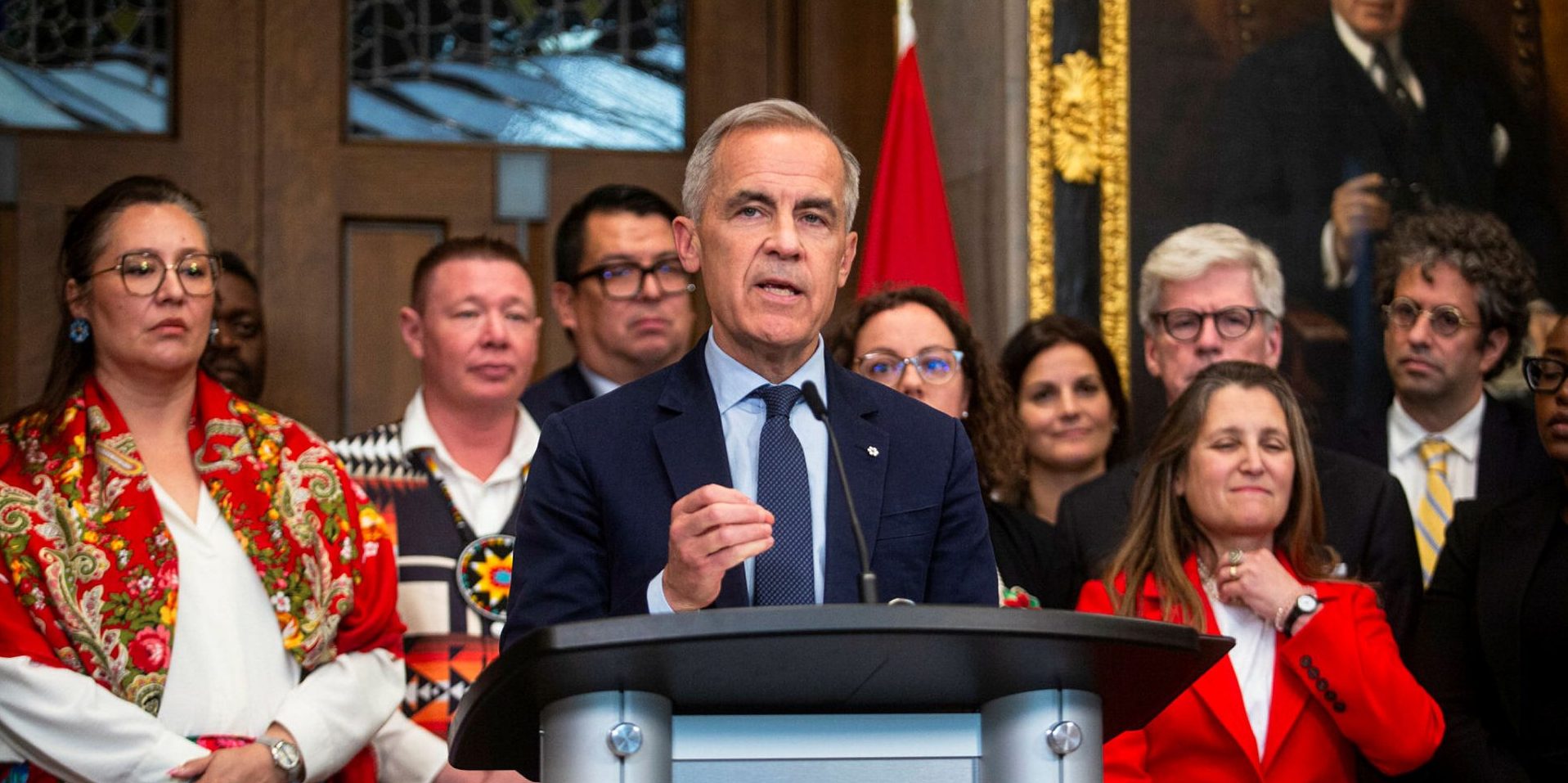Breaking down C-5: Carney’s ‘build, baby, build’ bill draws support from business sector, but heavy pushback from environmental, Indigenous groups

Bill C-5, the controversial legislation intended to remove Canada’s internal trade barriers and expedite major projects, has been criticized as a “power grab” by the federal government, but has also drawn support from the business sector as a way to inject a much-needed financial boost amid a time of economic threats from the United States.
“We’ve got a fiscal framework that’s extremely stressed. We’ve also got, obviously, geopolitical tensions and new pressures coming from the U.S. We’ll see if they’re temporary or not as our governments continue to work to find some new path forward,” said Michael Gullo, vice-president of policy for the Business Council of Canada (BCC). “We have to get going, and the longer we wait, I think, the risks are heightened.”
Bill C-5, or the “One Canadian Economy Act,” was tabled by Canada-United States Trade and Intergovernmental Affairs Minister Dominic LeBlanc (Beauséjour, N.B.) on June 6, and then swiftly moved through the House. Senator Hassan Yussuff (Ontario) of the Independent Senators Group sponsored the bill in the Red Chamber, which passed in the Senate and received royal assent on June 26.
The first part of the bill enacts the Free Trade and Labour Mobility in Canada Act, which seeks to remove federal barriers to the interprovincial trade of goods and services, and also to improve labour mobility within Canada. According to the bill, any goods produced, used, or distributed in accordance with a provincial or territorial requirement would be considered to have met any comparable federal provision, provided the requirements respect the same aspect or element of the item; are intended to achieve a similar objective; and meet any conditions set out in the regulations. Similarly, any service meeting provincial or territorial standards would be treated as meeting federal standards if they meet those equivalent conditions.
The act also provides the governor-in-council with the power to make regulations respecting federal barriers to the interprovincial movement of goods and provision of services and to the movement of labour within Canada.
Gullo described Bill C-5 as long overdue, and described internal trade barriers as a self-imposed goods and services tax that adds “six to seven per cent more on just about everything that we do.”

In a report released on Feb. 13, the BCC argued that Canada’s internal barriers to trade and labour mobility essentially act as domestic tariffs, and that the negative effects on the country’s economic competitiveness, productivity and growth are “as great if not greater than the impact of the threatened tariffs on Canadian exports to the U.S.”
A September 2022 report from the Macdonald-Laurier Institute estimated that removing interprovincial trade barriers could result in growth of $200-billion annually to Canada’s economy through the elimination of regulatory mismatches between provinces.
The Free Trade and Labour Mobility in Canada Act represents a federal effort to reinforce the principle of “mutual recognition” as the primary tool for removing barriers, according to Gullo.
“There’s an example where food that is destined to be exported to another province or internationally has to be approved by a federal facility, using federal inspectors, right?” he said. “Now you’ve got an attempt here to rectify that and say, ‘Well, provincial systems, providing they meet certain standards, will be capable of doing the same thing.’ So, you get rid of that redundancy because often these are goods that are regulated at a local and regional level as well.”
Some criticism of the Free Trade and Labour Mobility in Canada Act has come from the Canadian Meat Council. Lauren Martin, the council’s senior director of public affairs, argued that the act could lead the federal government to recognize provincial rules for inspecting meat as equal to federal standards, which is a “red flag” because the two standards are not equivalent, as reported by Global News on June 24. In response to this concern, the office of Internal Trade Minister Chrystia Freeland (University—Rosedale, Ont.) said the federal government doesn’t intend to dispense with any regulations if it would lead to serious health and safety concerns, according to the Global News report.
In terms of labour mobility, Siobhán Vipond, executive vice-president of the Canadian Labour Congress, told The Hill Times that her organization agrees with the bill’s objective, but has some concerns about what implementation would actually look like in terms of how workers’ rights and safety standards will be protected.

“Our eye is always to making sure that we’re raising the standards or we’re meeting standards —[that] it’s not being used as an opportunity to ignore some standards that have been hard-fought [for], and that workers are trying to protect,” she said.
“There’s lots of people who move for work in Canada, and they should be recognized for the skills they have … but the quicker project launching has to be still maintaining the standards that have been put in place.”
Vipond said that, under this law, if federal and provincial standards are similar—and businesses are meeting provincial standards—they’ll automatically be considered as meeting the federal standards.
“If a worker is certified to do a job in one province, then the federal government is going to recognize that certification at the federal level,” she said.
The Canadian Chamber of Commerce described Bill C-5 as rising to meet the moment of the national economic crisis due to the trade war with the United States, in a June 23 press release.
“In response, we must trade more within Canada, while looking at likeminded countries in Europe and around the world that are eager to buy our goods and resources. We cannot have all our eggs in the United States economic basket any longer,” said Matthew Holmes, the Chamber’s vice-president and chief of public policy, in the release.
Gullo said that not all barriers to internal trade are under Ottawa’s control, and so Bill C-5 would only be a first step. Examples of differing standards between provinces could include health and safety regulations and inspection requirements, as well as different packaging and labelling regulations.
“It’s a very strong step forward, but removing interprovincial trade barriers is going to require more sustained effort, even as this bill passes,” said Gullo.
Since its introduction, the Building Canada Act has received strong objections from some representatives of environmental and Indigenous groups.
Brenda Powell, an environmental lawyer and staff counsel with the Environmental Law Centre, told The Hill Times that the Building Canada Act turns the normal regulatory process on its head, to some extent.

“Normally what you do is you have a project, [and] you go through this process, and at the end of the process you decide whether or not the project should be approved,” she said.
“This [legislation] is starting with a ‘Yes, your project can go ahead,’ and then we’re going to figure out the conditions afterward.”
Under the Building Canada Act, the governor-in-council may designate a member of the King’s Privy Council for Canada as “the minister” for the purposes of the act, and that minister would have decision-making authority when it comes to national interest projects.
If, on the minister’s recommendation, cabinet determines that a project should be considered in the national interest, it may be added to a list—to be referred to as Schedule 1—of national interest projects.
The decision to add a project to Schedule 1 is to be based on factors such as whether a project would strengthen Canadian autonomy, resilience and security; provide economic or other benefits to the country; have a high likelihood of successful execution; advance the interests of Indigenous Peoples; and contribute to clean growth and to meeting Canada’s objectives with respect to climate change.
The minister would also be responsible for a new major federal projects office to help co-ordinate “the exercise of powers and the performance of duties and functions” under the Building Canada Act, and serve as a single point of contact for proponents of projects. Through this office, the minister would issue a single all-in-one document that functions as the authorization under various pieces of legislation in respect to a project, rather than multiple ministers issuing individual regulatory decisions. Energy Minister Tim Hodgson (Markham-Thornhill, Ont.) said on May 23 in Calgary that the Major Federal Projects Office would reduce approval schedules for nationally significant projects from five years to two.
Several amendments, intended to improve transparency, were made to Bill C-5 on June 19. While previously there was no requirement for the minister to provide an explanation for why a project has been added to Schedule 1, an amendment now requires that the minister establish and maintain a public registry of national interest projects that is publicly accessible online. The registry must include a detailed description of the project, the reasons why it is of “national interest,” and must contain other important project details such as cost estimates and timelines for completion.
Before adding a project to Schedule 1, a 30-day notice is also to be published in the Canada Gazette, and the governor-in-council must consult with the government of the province in which the project will be carried out, and obtain written consent if the project falls within areas of exclusive provincial jurisdiction. Another amendment states that if the national interest project has not been “substantially started” within five years of the issuance of the document from the minister, the document expires.
Powell said that these amendments have somewhat addressed earlier objections about transparency, but she is still concerned about a lack of required public consultations when it comes to national-interest projects.
“Public consultation often brings to the forefront concerns that the [project] proponent might not necessarily raise in their application. There might be important issues raised in public consultation that don’t otherwise arise,” she said.
“I think you hear a lot about delay caused by environmental regulation, but it’s important to remember those regulations are in place for a reason. We have fisheries legislation in place to protect fish habitat, and if you don’t apply that, then there’s a possibility that you’re going to have damage to water.”
Charlie Hatt, climate program director for Ecojustice, said he was “deeply troubled” by Bill C-5, and argued the federal government is “using the need for economic independence as an excuse to undermine robust environmental protection and meaningful consultation with First Nations,” in a June 6 press release.
Linda Nowlan, acting executive director of the David Suzuki Foundation, argued that without crucial amendments, Bill C-5 could be used to bypass essential environmental laws and “force through oil and gas projects and pipelines and derail climate progress in Canada.”
“Even in a crisis, it is simply irresponsible to pre-approve projects without environmental oversight, meaningful public participation and full recognition of Indigenous rights. Plenty of projects in Canada’s national interest can be pursued without compromising essential climate, nature and human rights standards including a clean electricity grid, renewable energy expansion and public transit improvements,” said Nowlan in the press release.
Rachel Doran, executive director of Clean Energy Canada, said in a June 23 press release the bill could achieve “big things” for the clean economy, depending on details of implementation.
“For example, fast-tracking transmission projects can enhance Canada’s energy security and get more Canadian-made clean power to industrial facilities. Ensuring workers required to build clean economy projects (such as geologists, engineers, EV mechanics, wind turbine technicians, and heat pump installers) are prioritized in labour mobility efforts can also help get clean growth projects built faster,” she said in the press release.
But she called for amendments that would make contributing to Canada’s climate goals a “must-have” condition for a project, and a shorter time horizon—such as three years—for the “extraordinary powers” connected to C-5.
Another key amendment to the bill on June 19 was the removal of the Indian Act from “Schedule 2,” or the list of acts of Parliament that may be bypassed for the projects listed in Schedule 1. The Indian Act was then added to a list of acts—which also includes the Criminal Code and the Canada Labour Code—that would be prohibited from being added to Schedule 2 at a later time.
Another amendment requires a process that “allows for the active and meaningful participation of the affected Indigenous peoples” before the minister issues conditions for a project to be approved.
Christina Gray, an associate at JFK Law LLP specializing in Indigenous rights advocacy, told The Hill Times that greater clarity is needed around what “meaningful participation” actually means.

“What is in the national interest? There are some factors, and the prime minister has said that this summer he is going to consult with Indigenous Peoples around consultation, but hasn’t really given a lot of context about what would be consulted,” she said.
“I think it’s really important to hear from Indigenous Peoples at the committee stage, and also as part of this legislative process in the House of Commons and how it will impact Indigenous people throughout Canada, especially as it pertains to the duty to consult and, when necessary, accommodate.”
Gray is a member of the Ts’msyen community of Lax Kw’alaams, B.C., and Dene from Łutselkʼe, N.W.T.
Gray said it’s important to note that First Nations and Indigenous Peoples don’t necessarily speak with one voice.
“I would have liked to have seen more amendments made to strengthen, especially, the provision around what is now meaningful participation around the consultation process, and to outline specifically, ‘Well, here’s the steps,’ and then also, what does national interest projects mean?” she said. “There’s a lack of definitions in the legislation itself.”
The Assembly of First Nations announced plans to convene a national virtual forum on July 10 to bring together First Nations leaders to discuss Bill C-5, as a continuation of a similar virtual forum that was conducted on June 16.
During the June forum, chiefs raised concerns about the bill in regard to a “rushed legislative process, lack of meaningful consultation, narrowly defined national interest that excludes First Nations priorities and perspectives, a failure to support First Nations priorities such as closing the infrastructure gap, and the broader implications for rights and jurisdiction,” according to a statement on June 17.
According to the bill, the governor-in-council’s power to list projects expires five years after the legislation comes into force.
David Wright, an associate professor at the University of Calgary whose teaching and research covers areas including natural resources law, environmental law, and Indigenous law, told The Hill Times that the five-year deadline could be intended to more or less mirror the federal election cycle in Canada, and also to extend shortly after the second term of U.S. President Donald Trump.
“They’re not using the term ‘emergency’ here, but I think what it seems like they’re trying to do is mimic the approach a government would take in an emergency scenario—giving themselves quite extraordinary powers, but only for the duration of the emergency,” he said. “When you consider that President Trump’s term is going to be four years, [and] we’re not even six months into that … five years will cover his term and then some and then, ideally, the quote ‘emergency’ will be passed.”
Sec. 19 of the Building Canada Act provides that if a national interest project is also a designated project under the federal Impact Assessment Act (IAA), then it is not subject to sections 9 to 17 and subsections 18(3) to (6) of the IAA. This means that, although the IAA process would still apply, the 180-day planning phase would be eliminated.
The Hill Times
Amendments to Bill C-5 Made on June 19:
Note: In Bill C-5, under the Building Canada Act, “Schedule 1” refers to the list of projects deemed to be in the national interest. That list is currently empty. “Schedule 2” is a list of acts of Parliament that may be bypassed for the projects listed in Schedule 1. These acts include the Fisheries Act, the Canada Transportation Act, and the Species At Risk Act. The Indian Act was previously included in Schedule 2, but has since been removed.
- The preamble of the Building Canada Act now states that creating “good-paying, unionized jobs” is among the goals of national interest projects.
- In the list of definitions for the Building Canada Act, it clarifies that “parliamentary review committee” means the committee referred to in subsection 62(1) of the Emergencies Act.
- The governor-in-council may, by order, define “national interest” for the purposes of section 5 (which outlines the power of the governor-in-council). Those orders by the governor-in-council must set out specific criteria that must be met by the proponent of a project in order for the project to be found to be in the national interest. If an order is not made within 15 days after the day on which the act came into force, the minister must, within five sitting days of the end of that period, cause to be tabled in each House of Parliament a report that sets out the reasons for the delay and the expected timeline for the making of the order.
- Under the power of the governor-in-council, it now specifies that if the governor-in-council is of the opinion that a project is of national interest, they may amend Schedule 1 to add the name of that project, along with a detailed project description and the location where it is to be carried out. Before adding the name of a project to Schedule 1, a 30-day notice is to be published in the Canada Gazette, and the governor-in-council must consult with the government of the province in which the project will be carried out, and obtain written consent if the project falls within areas of exclusive provincial jurisdiction.
- The first reading of the bill said that the governor-in-council is not authorized to make an order under subsection (1) after the fifth anniversary of the day that section came into force. This was amended to also state they are not authorized to make an order under subsection (1) while Parliament is prorogued or dissolved. The minister is also not authorized to amend a condition under subsection (1) while Parliament is prorogued, dissolved or after the fifth anniversary of the day on which this section comes into force.
- Before recommending that an order be made under subsection (1), the minister must be satisfied that the proponent of the project (or any director, officer or significant shareholder of the proponent) has not been found to have committed a violation under the Conflict of Interest Act and is not the subject of an ongoing proceeding in respect of a violation under that act; and every reporting public office holder who could be in a conflict of interest in relation to the proponent of the project has recused themselves to avoid the conflict.
- The minister must establish and maintain a public registry of national interest projects that is publicly accessible through the Internet. Within 30 days after an order is made under subsection (1), details of the project in respect of which the order is made must be published in the public registry. The registry must include a detailed description of the project, the reasons why it is of “national interest,” and information such as cost estimates and project timelines for completion.
- The minister must undertake a national security review for all state-owned or foreign investments from hostile countries in any national interest project. The minister must also be satisfied that all necessary measures have been taken to protect national security interests when it comes to foreign investments in the project.
- In regard to Indigenous Peoples, the minister must ensure that a process is established that allows for the “active and meaningful participation” of affected Indigenous Peoples, and that a report of the consultation process and results be made available to the public within 60 days after the day on which a document is issued under subsection (1).
- An expiry rule was added, stating that if the national interest project has not been “substantially started” within five years of the issuance of the document, the document expires.
- The documents issued to the project proponent by the minister (that sets out conditions that apply in respect of the project and that is deemed to be the authorizations), must be made public, along with the information used to issue the document. The minister must make public all the conditions that apply to the project; the full contents of the studies and impact assessments conducted regarding the project; all the recommendations received from federal departments and agencies, provinces, territories and Indigenous Peoples regarding the project; the reasons some of the recommendations were not accepted; and a description of the normal regulatory process that would have been followed if the project had not been designated as a national interest project.
- A list was included of acts of Parliament that the governor-in-council is not authorized to add to Schedule 2. This includes the Canada Elections Act, the Criminal Code, the Indian Act, and the Canada Labour Code.
- The governor-in-council may make regulations generally for carrying out the purposes and provisions of the act, but they may not make regulations under subsection (1) while Parliament is prorogued or dissolved or after the fifth anniversary of the day on which this section comes into force.
- A requirement for an annual report was added to the bill, stating that, within 90 days after the end of each financial year, the minister must cause an independent review to be conducted of the status of each national interest project providing an assessment of the progress made on measurable outcomes, including in relation to timelines and budgets. A report of the review must be tabled in each House of Parliament on any of the first 15 days on which that House is sitting after the review is completed, and the minister must publish the report online within 10 days of the report being tabled.
- A parliamentary review committee is to review how the governor-in-council and the minister “exercise” their powers and the “performance of their duties and functions,” and to report the review results at least every 180 days, unless Parliament is prorogued or dissolved.
- The minister must complete a review of the provisions and operation of the act, and must cause a report on the review to be laid before the parliamentary review committee and each House of Parliament within five years of when the act came into force.






 LICENSING
LICENSING PODCAST
PODCAST ALERTS
ALERTS













